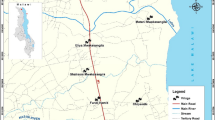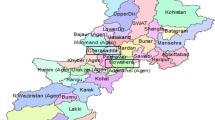Abstract
Flood risk studies remain focused on understanding causation, impacts, perceptions and coping and adaptation measures and there remain many inappropriate measures taken to reduce household risk. Through a case study approach, this study assessed rural household vulnerability to flooding which helped to determine the level of risk to flood hazards in Mbire District of Zimbabwe. Three hundred and thirty-five (335) households were randomly selected to participate in the survey. The composite index approach was used to calculate vulnerability and risk indices. Results indicated that more than 70% of the households were highly vulnerable to flooding and about 50% were in the medium to very high categories of flood risk. Household vulnerability was not only a question of the natural flood event, but a result of the intersection of poor socio-economic conditions and the physical exposure to floods. The socio-economic determinants of vulnerability included high levels of unemployment resulting in low income and poverty; low levels of education; and over-dependence of the community on rain-fed smallholder farming. Physical exposure of the community mainly resulted from materials used to construct houses. Pole and dagga houses had a higher degree of exposure compared to houses with bricks and cement. Therefore, we recommend that instead of focusing on the whole ward/district the institutional services should first target the most vulnerable and at risk households in order to increase their capacity in dealing with flood hazards.


Similar content being viewed by others
References
Adelekan IO (2011) Vulnerability assessment of an urban flood in Nigeria: Abeokuta flood 2007. Nat Hazards 56(1):215–231. https://doi.org/10.1007/s11069-010-9564-z
Adeloye AJ, Mwale FD, Dulanya Z (2015) A metric-based assessment of flood risk and vulnerability of rural communities in the Lower Shire Valley, Malawi. IAHS-AISH Proc Rep 370:139–145. https://doi.org/10.5194/piahs-370-139-2015
Antwi-Agyei P, Dougill AJ, Fraser EDG, Stringer LC (2013) Characterising the nature of household vulnerability to climate variability: empirical evidence from two regions of Ghana. Environ Dev Sustain 15:903–926. https://doi.org/10.1007/s10668-012-9418-9
Birkmann J, Cardona OD, Carreno ML, Barbat AH, Pelling M, Schneiderbauer S, Welle T (2012) Framing vulnerability, risk and societal responses: the MOVE framework. Nat Hazards 67:193–211. https://doi.org/10.1007/s11069-013-0558-5
Boccard N (2018) Natural disasters trends (January). https://doi.org/10.2139/ssrn.3116231
Bola G, Mabiza C, Goldin J, Kujinga K, Nhapi I, Makurira H, Mashauri D (2014) Coping with droughts and floods: a case study of Kanyemba, Mbire District, Zimbabwe. Phys Chem Earth 67–69(January):180–186. https://doi.org/10.1016/j.pce.2013.09.019
Chingombe W, Pedzisai E, Manatsa D, Mukwada G, Taru P (2015) A participatory approach in GIS data collection for flood risk management, Muzarabani district, Zimbabwe. Arab J Geosci. https://doi.org/10.1007/s12517-014-1265-6
Cutter SL, Boruff BJ, Shirley WL (2003) Social vulnerability to environmental hazards. Soc Sci Q 84(2):242–261
Fang Y, Zhao C, Rasul G, Wahid SM (2016) Rural household vulnerability and strategies for improvement: an empirical analysis based on time series. Habitat Int 53:254–264. https://doi.org/10.1016/j.habitatint.2015.11.035
Gain AK, Mojtahed V, Biscaro C, Balbi S, Giupponi C (2015a) An integrated approach of flood risk assessment in the eastern part of Dhaka City. Nat Hazards 79(3):1499–1530. https://doi.org/10.1007/s11069-015-1911-7
Gain AK, Mojtahed V, Biscaro C, Balbi S, Giupponi C (2015b) An integrated approach of flood risk assessment in the eastern part of Dhaka City. Nat Hazards 79:1499–1530. https://doi.org/10.1007/s11069-015-1911-7
Gerlitz JY, Macchi M, Brooks N, Pandey R, Banerjee S, Jha SK (2017) The Multidimensional Livelihood Vulnerability Index–an instrument to measure livelihood vulnerability to change in the Hindu Kush Himalayas. Clim Dev 9(2):124–140. https://doi.org/10.1080/17565529.2016.1145099
Gumindoga W, Makurira H, Phiri M, Nhapi I (2016) Estimating runoff from ungauged catchments for reservoir water balance in the lower middle Zambezi basin. Water SA 42(4):641–649. https://doi.org/10.4314/wsa.v42i4.15
Gwimbi P (2009) Cotton farmers’ vulnerability to climate change in Gokwe District (Zimbabwe): impact and influencing factors. J Disaster Risk Stud 2(2):81–92
Hahn MB, Riederer AM, Foster SO (2009) The livelihood vulnerability index: a pragmatic approach to assessing risks from climate variability and change—a case study in Mozambique. Glob Environ Change 19(1):74–88
Kablan MKA, Dongo K, Coulibaly M (2017a) Assessment of social vulnerability to flood in urban Côte d’Ivoire using the MOVE framework. Water (Switzerland) 9(4):1–19. https://doi.org/10.3390/w9040292
Kablan MKA, Dongo K, Coulibaly M (2017b) Assessment of social vulnerability to flood in urban Côte d’Ivoire using the MOVE framework. Water (Switzerland). https://doi.org/10.3390/w9040292
Kolen B, van Gelder PHAJM (2018) Risk based decision making for evacuation in case of iminent threat of flooding. Water. https://doi.org/10.3390/w10101429
Lianxiao Morimoto T (2019) Spatial analysis of social vulnerability to floods based on the MOVE framework and information entropy method: Case study of Katsushika Ward, Tokyo. Sustainability (Switzerland). https://doi.org/10.3390/su11020529
López-Martínez F, Gil-Guirado S, Pérez-Morales A (2017) Who can you trust? Implications of institutional vulnerability in flood exposure along the Spanish Mediterranean Coast. Environ Sci Policy 76:29–39
Martin M (2010) Child participation in disaster risk reduction: the case of flood affected children in Bangladesh. Third World Q 31(8):1357–1375
Mavhura E (2019) Analysing drivers of vulnerability to flooding: a systems approach. S Afr Geogr J 101(1):72–90. https://doi.org/10.1080/03736245.2018.1541020
Mavhura E, Manyena B, Collins AE (2017) An approach for measuring social vulnerability in context: the case of flood hazards in Muzarabani district, Zimbabwe. Geoforum 86(September):103–117. https://doi.org/10.1016/j.geoforum.2017.09.008
Mhlanga C, Muzingili T, Mpambela M (2019) Natural disasters in Zimbabwe: the primer for social work intervention. Afr J Soc Work 9(1):46–54
Mucherera B, Mavhura E (2020) Flood survivors’ perspectives on vulnerability reduction to floods in Mbire district, Zimbabwe. 1–12
Mudavanhu C, Manyena SB, Collins AE, Bongo P, Mavhura E, Manatsa D (2015) Taking children’s voices in disaster risk reduction a step forward. Int J Disaster Risk Sci 6(3):267–281. https://doi.org/10.1007/s13753-015-0060-7
Munyai RB, Musyoki A, Nethengwe N (2019) An assessment of flood vulnerability and adaptation: a case study of Hamutsha-Muungamunwe village, Makhado municipality, Jàmbá. J Disaster Risk Stud 11(2):1–8
Notenbaert A, Karanja SN, Herrero M, Felisberto M, Moyo S (2013) Derivation of a household-level vulnerability index for empirically testing measures of adaptive capacity and vulnerability. Reg Environ Change 13(2):459–470. https://doi.org/10.1007/s10113-012-0368-4
Nur I, Shrestha KK (2017) An integrative perspective on community vulnerability to flooding in cities of developing countries. Proc Eng 198(September 2016):958–967. https://doi.org/10.1016/j.proeng.2017.07.141
Papathoma-Köhle M, Gems B, Sturm M, Fuchs S (2017) Matrices, curves and indicators: a review of approaches to assess physical vulnerability to debris flows. Earth Sci Rev 171:272–288
Pati RC, Cruz AP (2017) Flood vulnerability of the Town of Tanay, Rizal, Philippines. Philipp J Sci 146(June):117–127
Rana IA, Routray JK (2018) Multidimensional model for vulnerability assessment of urban flooding: an empirical study in Pakistan. Int J Disaster Risk Sci 9(3):359–375. https://doi.org/10.1007/s13753-018-0179-4
Salami RO, Giggins H, Salami R, Meding V (2017) Vulnerability of human settlements to flood risk in the core area of Ibadan metropolis, Nigeria. 1–14
Shah AA, Ye J, Abid M, Khan J, Amir SM (2018) Flood hazards: household vulnerability and resilience in disaster-prone districts of Khyber Pakhtunkhwa province, Pakistan. Natu Hazards 93(1):147–165. https://doi.org/10.1007/s11069-018-3293-0
Shah AA, Shaw R, Ye J, Abid M, Amir SM, Kanak Pervez AKM, Naz S (2019a) Current capacities, preparedness and needs of local institutions in dealing with disaster risk reduction in Khyber Pakhtunkhwa, Pakistan. Int J Disaster Risk Reduct 34(July 2018):165–172. https://doi.org/10.1016/j.ijdrr.2018.11.014
Shah AA, Ye J, Shaw R, Ullah R, Ali M (2019b) Factors affecting flood-induced household vulnerability and health risks in Pakistan: The case of Khyber Pakhtunkhwa (KP) province. Int J Disaster Risk Reduct. https://doi.org/10.1016/j.ijdrr.2019.101341
Suryanto S, Rahman A (2019) Application of livelihood vulnerability index to assess risks for farmers in the Sukoharjo Regency and Klaten Regency, Indonesia, Jàmbá. J Disaster Risk Stud 11(1):1–9. https://doi.org/10.4102/jamba.v11i1.739
Thouret J, Ettinger S, Guitton M, Santoni O, Magill C, Martelli K, Zuccaro G, Revilla V, Charca JA, Arguedas A (2014) Assessing physical vulnerability in large cities exposed to flash floods and debris flows: the case of Arequipa (Peru). Nat Hazards 73(3):1771–1815
UNISDR (2015) Proposed updated terminology on disaster risk reduction : a technical review facilitated by the United Nations Office for Disaster Risk Reduction August 2015 Background and History of Disaster Risk Reduction Terminology (August)
Weis SWM, Agostini VN, Roth LM, Gilmer B, Schill SR, Knowles JE, Blyther R (2016) Assessing vulnerability: an integrated approach for mapping adaptive capacity, sensitivity, and exposure. Clim Change 136(3–4):615–629
Welle T, Depietri Y, Angignard M, Birkmann J, Renaud F, Greiving S (2014) Vulnerability assessment to heat waves, floods, and earthquakes using the move framework: test case Cologne, Germany. In: Birkmann J, Kienberger S, Alexander DE (eds) Assessment of vulnerability to natural hazards. Elsevier, Bonn, pp 91–124
Willroth P, Diez JR, Arunotai N (2011) Modelling the economic vulnerability of households in the Phang-Nga Province (Thailand) to natural disasters. Nat Hazards 58(2):753–769
Wisner B, Blaikie P, Cannon T, Davis I (2004) At risk: Natural hazards, people’s vulnerability and disasters, 2nd edn. Routledge, London
Yoon DK (2012) Assessment of social vulnerability to natural disasters: a comparative study. Nat Hazards 63(2):823–843
Acknowledgements
This study was funded by the European Civil Protection Organisation (ECHO) as part of the project titled: “Enhancing Disaster Preparedness in Most Vulnerable Flood Prone Districts of Zimbabwe through Multi-Level Capacity Building in Mbire and Muzarabani District” through World Vision Zimbabwe. Many thanks go to World Vision Zimbabwe for partnering with Bindura University of Science Education.
Author information
Authors and Affiliations
Corresponding author
Ethics declarations
Conflict of interest
The authors do not have any competing interests.
Additional information
Publisher's Note
Springer Nature remains neutral with regard to jurisdictional claims in published maps and institutional affiliations.
Rights and permissions
About this article
Cite this article
Mudavanhu, C., Manyangadze, T., Mavhura, E. et al. Rural households’ vulnerability and risk of flooding in Mbire District, Zimbabwe. Nat Hazards 103, 3591–3608 (2020). https://doi.org/10.1007/s11069-020-04145-y
Received:
Accepted:
Published:
Issue Date:
DOI: https://doi.org/10.1007/s11069-020-04145-y




